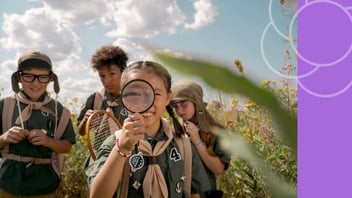Expand Your Child's Education Through Holistic Learning
Conventional education isn’t without its benefits, but it also has drawbacks, including a lack of focus on skills children need to thrive in life – like creativity and critical thinking. In fact, according to a report by the Lego Foundation, 90% of a child’s creativity is lost during the school years.
Here, we’ll explore the gaps in traditional education that holistic education fills and the benefits of Bloomster’s holistic approach.
Holistic Learning Encourages Critical Thinking
The traditional classroom is chock full of facts. Whether math or social studies, learning is frequently about absorbing information and being able to recall it for tests.
Unfortunately, this type of learning bypasses critical thinking. Essentially, instead of nurturing curiosity and being encouraged to ask questions, children become passive listeners. But according to a Reboot Foundation survey, 35% of people believe a child is best taught critical thinking between the ages of six and 12, making these the ideal years for their development.
Where the conventional education system fails, a platform like Bloomster can help a young learner engage with the subject. By developing critical thinking skills, a child will be able to really listen and have the capacity to question the world around them.
The Holistic Learning Journey is Personalized
According to one NASA study, 98% of preschoolers were considered to be creative geniuses. As this group moved into grade school, the number dropped to 30%, with the number sliding further to 12% in their high school years.
Unfortunately, because conventional education typically uses a one-size-fits-all approach, children’s individual skills and contributions are often overlooked. Standardized curricula and testing leave little room for exploration, self-discovery, or the development of unique talents. While learning a variety of subjects and methods is important, it shouldn’t come at the cost of acknowledging each child’s innate strengths. When students aren’t given the opportunity to nurture their passions, their full potential remains untapped.
Holistic learning, on the other hand, embraces a personalized approach by recognizing that every child learns differently. Some children thrive through visual storytelling, others excel with hands-on experimentation, and some absorb information best through discussion and collaboration. By allowing students to engage with material in a way that aligns with their learning style, holistic education fosters deeper comprehension, greater retention, and more meaningful connections to the material.
This individualized approach also encourages children to take an active role in their education, boosting their confidence and motivation. When students feel seen, valued, and supported in their strengths, they develop a stronger sense of identity and purpose. Whether a child is a budding artist, an analytical thinker, or a natural leader, holistic learning provides the flexibility needed to cultivate their talents while still building a strong foundation in essential academic skills.
By shifting the focus from standardized benchmarks to a more personalized and student-centered experience, holistic learning helps children become more engaged, self-directed learners who are better prepared to adapt, innovate, and succeed in an ever-changing world.
Learning Holistically Offers Improved Flexibility
Traditionally, children sit at their desks for seven hours a day, five days a week. Unfortunately, this regimented schedule doesn’t inspire learning, nor is it the most efficient. The Brandon-Hall Group determined that online learning takes 40-60% less time than a traditional classroom, and for this reason, many students are making different choices about how best to learn.
Holistic learning recognizes that education isn’t just about memorizing facts—it’s about fostering curiosity, critical thinking, and problem-solving skills that children can carry with them throughout life. By allowing students to engage in learning through various formats—whether through interactive digital lessons, project-based exploration, or hands-on experiences—education becomes more adaptable to individual needs.
This personalized educational approach encourages deeper engagement and creativity. Rather than adhering to a rigid curriculum, students can explore subjects at their own pace, making connections between concepts in a way that feels natural and meaningful. When learning is flexible, children are more likely to stay motivated and develop a lifelong love for acquiring knowledge.
Limited Interaction and Collaboration
A significant portion of childhood development happens by spending time and working with others. Not only is the play fun, but these interactions help a child build relationships and social skills.
Conventional education does not typically place emphasis on teamwork and collaboration, which are important assets in school, during athletics, in the workplace and more. Did you know? According to a Frost & Sullivan statistic, collaboration improves innovation at work by 30% and productivity by 36%!
Bloomster offers a place where a child can learn firsthand the benefits of teamwork and understanding the importance of collaboration and community.
Class Length
The harrowing statistic on our decreasing attention span is common knowledge, but in case you need the refresher: a 2015 Microsoft study revealed that the average attention span has dropped from 12 seconds in 2000 to just eight seconds today!
Despite controversy around this stat, we all know focusing in our digitized world is increasingly difficult. Most middle school children can only pay attention for 24-36 minutes, which is significantly shorter than the average class length of 45-60 minutes. This fact both renders the standard class too long and illustrates the benefit of online platforms’ more segmented learning. By interspersing videos and lectures with interactive quizzes, students can remain engaged throughout their chosen studies.
Fortunately, through a personalized learning journey, a student can access a more comprehensive, ever-evolving education platform that is more effective and engages each student’s talents.
Ready to accelerate your child’s growth and promote the benefits and experience of holistic learning? Sign up for 30-days free access to SEL Courses for teens.



.png?width=352&name=Parent%20and%20child%20having%20an%20open%20conversation%20about%20peer%20challenges%20(1).png)
